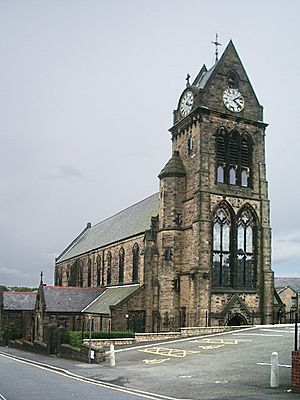St Cuthbert's Church, Darwen facts for kids
Quick facts for kids St Cuthbert's, Darwen |
|
|---|---|

St Cuthbert's Church in 2008
|
|
| Lua error in Module:Location_map at line 420: attempt to index field 'wikibase' (a nil value). | |
| OS grid reference | SD 68537 23302 |
| Location | Darwen, Lancashire |
| Country | England |
| Denomination | Anglican |
| Architecture | |
| Functional status | Active |
| Heritage designation | Grade II |
| Architect(s) | Paley and Austin |
| Specifications | |
| Materials | Sandstone |
| Administration | |
| Parish | Darwen with Tockholes |
| Deanery | Blackburn with Darwen |
| Archdeaconry | Blackburn |
| Diocese | Blackburn |
| Province | York |
St Cuthbert's Church is an Anglican church in the English market town of Darwen, Lancashire. It is an active parish church that serves the local community. The church was built between 1875 and 1878 by a famous architecture firm called Paley and Austin. St Cuthbert's is considered a special building. It has been officially recognized as a Grade II listed building by English Heritage.
Contents
History of St Cuthbert's
St Cuthbert's Church was built from 1875 to 1878. It was designed by the architectural company Paley and Austin from Lancaster. A tall tower was added to the church later, between 1907 and 1908.
On September 27, 1984, English Heritage officially named the church a Grade II listed building. This means the building is "nationally important and of special interest." It's the lowest of three grades, but still very important.
St Cuthbert's is an active church within the Church of England. It is part of the Diocese of Blackburn, which is a large area managed by a bishop. This diocese belongs to the Province of York, a bigger church region. The church is also part of the Blackburn archdeaconry and the Blackburn with Darwen Deanery. The local church area, or parish, is called Darwen St Cuthbert with Tockholes St Stephen.
What the Church Looks Like
Outside the Church
St Cuthbert's Church is built from yellow sandstone, which is a type of rock. Its roofs are made of slate, a dark gray stone. At the west end of the church, there is a tall tower. The church also has a main area called a nave, with smaller sections on the sides called aisles. There is a special area for the altar called the chancel and a room for the clergy called a vestry.
On the north and south sides of the nave, there are parts that stick out, known as transepts. The tower is rectangular and has three levels. It has a pointed roof, called a gabled roof. You can see clock faces high up on each side of the tower. Where the tower meets the nave on the north-east side, there is a small, many-sided tower called a turret.
The west wall of the tower has two large windows. These windows have horizontal bars called transoms and decorative stone patterns called tracery. There are also windows for the belfry on this wall, where the church bells are.
The main part of the church, the nave, has windows high up, in an area called the clerestory. These windows have two sections and decorative tops shaped like five leaves, called cinqufoil heads. The east window in the chancel is very large, with five sections and beautiful tracery.
Inside the Church
Inside, the nave has four sections, called bays. The rows of arches, known as the arcade, are supported by eight-sided columns. In the chancel, there is a beautiful marble screen behind the altar called a reredos. This reredos was designed by a company named Powell.
The church has lovely stained glass windows. One of these is a war memorial made by Morris & Co.. Another window shows images of Saint Chad and Saint Cuthbert. This window was created by a company from Lancaster called Shrigley and Hunt.
The church organ was brought from the parish church at Kendal in 1877. The wooden case around the organ was made by a famous organ builder named Bernard Smith.
See also
- Listed buildings in Darwen
- List of ecclesiastical works by Paley and Austin

